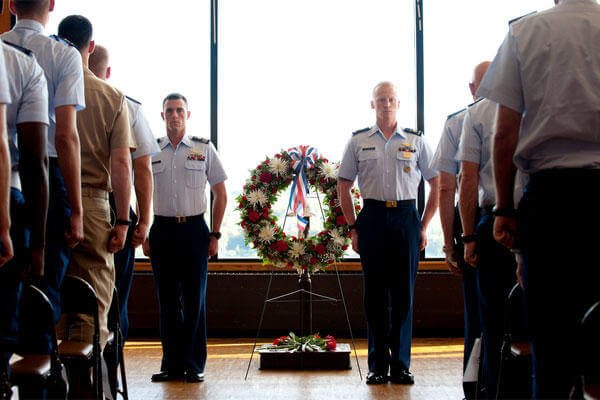On a cool October afternoon in 1978, Coast Guard Cutter Cuyahoga sailed peacefully at the mouth of the Chesapeake Bay. The cutter hosted a company of eager officer candidates underway for a training cruise. It would prove to be Cuyahoga’s last voyage.
The 125-foot Cuyahoga began her long and varied career in 1927, when she was commissioned in Camden, N. J. She spent her years hunting rum runners during Prohibition and served as a tender for the presidential yacht, an escort in the Caribbean during World War II and finally as a training platform for future Coast Guard officers.
While underway on Oct. 20, 1978, the Cuyahoga was struck by a 521-foot coal freighter. The impact was devastating and the Cuyahoga sank within minutes. Eleven men lost their lives.
Every year since this tragic incident, memorial services are held in Yorktown, Va., and New London, Conn., the current home of Coast Guard Officer Candidate School. This year marks the 35th anniversary of the Cuyahoga sinking. The speaker at this year’s service in New London was Dr. Peter Eident, a former officer candidate and survivor of the Cuyahoga tragedy.
“It was the first time I’d ever been on a ship at sea,” said Eident during his address at the memorial service. “It was a cold, clear night. We were heading up the Chesapeake only 30 minutes from our destination.”
Eident was standing watch on the bridge that night. He heard a voice from above yell out “Contact on the port side!” It was the lookout. Shortly after, the Cuyahoga was struck by the freighter.
“There were sparks and grinding and gnashing of metal,” said Eident. “The ship dragged me down about ten feet. I fought my way to the surface and started to hyperventilate. I calmed myself down, and began to wonder how long I could tread water.”
Eident used buoyant deck boards for flotation until he saw the Cuyahoga’s 14-foot utility boat resurface. He swam frantically and eventually reached the boat.
“One by one, the survivors made it to the boat,” recalled Eident. “No one knew at the time exactly how many were missing. We kept calling out, but heard nothing.”
The loss of those 11 men was a painful blow to the service. It was of utmost importance to see that this type of incident was not repeated. It is through these types of tragedies that the Coast Guard learns and evolves.
“What are we to remember?” asked Eident. “I think those lost would want us to remember why accidents happen and how we can prevent them, because maybe we’ll be able to learn more from our mistakes than our triumphs.”
The eleven men who were lost on the Cuyahoga were on that cutter for one united, noble purpose: to serve. They each made the decision to devote their lives to the service of their country by becoming members and leaders of the U.S. Coast Guard.
“My classmates were smart, brave and dedicated,” said Eident. During the service in New London, current officer candidates placed 11 roses under the Cuyahoga’s bell, and rang it once for each man lost on that tragic night in 1978.
Remembering the tragedies of the past reminds us of the heavy responsibility the Coast Guard constantly bears. We are reminded to stand a vigilant watch, to maintain a steady course in our duties and our lives and to never allow the sacrifices of the brave men and women who have come before us to be in vain.


























